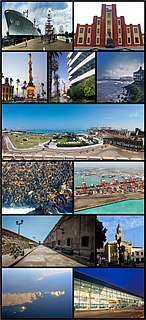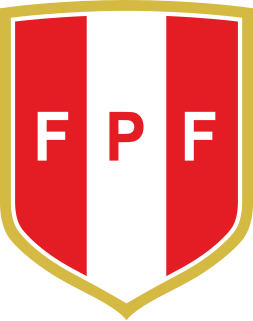Related Research Articles

Ecuador, officially the Republic of Ecuador, is a country in northwestern South America, bordered by Colombia on the north, Peru on the east and south, and the Pacific Ocean on the west. Ecuador also includes the Galápagos Islands in the Pacific, about 1,000 kilometres (621 mi) west of the mainland. The capital is Quito.

South America is a continent entirely in the Western Hemisphere and mostly in the Southern Hemisphere, with a relatively small portion in the Northern Hemisphere. It can also be described as a southern subcontinent of the Americas. The reference to South America instead of other regions has increased in recent decades due to changing geopolitical dynamics.

Francisco Pizarro González was a Spanish conquistador, best known for his expeditions that led to the Spanish conquest of Peru.

Machu Picchu is a 15th-century Inca citadel, located in the Eastern Cordillera of southern Peru, on a 2,430-metre (7,970 ft) mountain ridge. It is located in the Machupicchu District within Urubamba Province above the Sacred Valley, which is 80 kilometres (50 mi) northwest of Cuzco. The Urubamba River flows past it, cutting through the Cordillera and creating a canyon with a tropical mountain climate.

Lima is the capital and the largest city of Peru. It is located in the valleys of the Chillón, Rímac and Lurín Rivers, in the central coastal part of the country, overlooking the Pacific Ocean. Together with the seaport of Callao, it forms a contiguous urban area known as the Lima Metropolitan Area. With a population of more than 9 million, Lima is the second largest city in the Americas, after São Paulo.

Peru, officially the Republic of Peru, is a country in western South America. It is bordered in the north by Ecuador and Colombia, in the east by Brazil, in the southeast by Bolivia, in the south by Chile, and in the south and west by the Pacific Ocean. Peru is a megadiverse country with habitats ranging from the arid plains of the Pacific coastal region in the west to the peaks of the Andes mountains extending from the north to the southeast of the country to the tropical Amazon Basin rainforest in the east with the Amazon river. At 1.28 million km2, Peru is the 19th largest country in the world, and the third largest in South America.

Callao is a seaside city on the Pacific Ocean in the Lima metropolitan area. Callao is Peru's chief seaport and home to its main airport, Jorge Chávez International Airport. Callao municipality consists of the whole Callao Region, which is also coterminous with the Province of Callao. Founded in 1537 by the Spanish, the city has a long naval history as one of the main ports in Latin America and the Pacific, as it was one of vital Spanish towns during the colonial era. Central Callao is about 15 km (9.3 mi) west of the Historic Centre of Lima.

The Peru national football team represents Peru in men's international football. The national team has been organised, since 1927, by the Peruvian Football Federation (FPF). The FPF constitutes one of the 10 members of FIFA's South American Football Confederation (CONMEBOL). Peru has won the Copa América twice and qualified for FIFA World Cup finals five times ; it also participated in the 1936 Olympic football competition and has reached the semi-finals of the CONCACAF Gold Cup. The team plays most of its home matches at the Estadio Nacional in Lima, the country's capital.

The National University of San Marcos is a public research university in Lima, the capital of Peru. Also known as the University of Peru and the "Dean University of the Americas", it is the first officially established and the oldest continuously operating university in the Americas. Since its foundation, it was commonly referred as the "Royal and Pontifical University of the City of the Kings of Lima" until the Viceroyalty period and as of now, it is referred to as Universidad Nacional Mayor de San Marcos or La Decana de América.

Chifa is culinary tradition based on Chinese Cantonese elements fused with traditional Peruvian ingredients and traditions. Though originating in Peru, the Chifa tradition has spread to neighboring countries like Ecuador, Chile and Bolivia. Chinese immigrants came to Peru mainly from the southern province of Guangdong and particularly its capital city Guangzhou in the late 19th and early 20th centuries. They settled for the most part in the coast of Peru and the capital city of Lima. The term chifa is also used to describe a restaurant where this type of food is served. Chinese-Peruvian food has become one of the most popular types of food in Peru. The first Chinese–Peruvian fusion restaurants were opened in Lima in around 1920 in Lima's China town ; there are thousands of Chifa restaurants across all districts of Lima and many more throughout other cities of Peru, with sometimes multiple independent restaurants operating in close proximity on a single city block.
Peruvians are people identified with the country of Peru. There were Andean and Coastal Ancient civilizations like Caral, the oldest civilization of Peru and the Americas, who inhabited Peruvian territory for several millennia before the Spanish Conquest in the 16th century; Peruvian population decreased from an estimated 5–9 million in the 1520s to around 600,000 in 1620 mainly because of infectious diseases. Spaniards and Africans arrived in large numbers in 1532 under colonial rule, mixing widely with each other and with Native Peruvians. During the Republic, there has been a gradual immigration of European people. Chinese and Japanese arrived in large numbers at the end of the 19th century.
Flavius Probus, a Roman Senator and a v. nob. of Narbonne, then Narbo, was a man of literary taste and precocious ability. His father was Flavius Magnus, Consul of Rome in 460. He was a friend of Sidonius Apollinaris from their schooldays.
Thaumastus was a friend and uncle of Sidonius Apollinaris. His brother, the elder Apollinaris was born around 405 and was the praetorian prefect of Gaul under Valentinian III between 425 and 455. Thaumastus and his brother were both sons of another Apollinaris, praetorian prefect of Gaul before 409 and were friends with his successor Decimus Rusticus. Thaumastus was associated with Tonantius Ferreolus in the impeachment of Arvandus. He was the father of Eulalia, born in 425, married before 450 to Flavius Probus, Roman Senator.

Thaumastus flori is a species of tropical air-breathing land snail, a pulmonate gastropod mollusk in the family Megaspiridae.

Thaumastus is a genus of tropical air-breathing land snails, terrestrial pulmonate gastropod mollusks in the family Megaspiridae.
Kara is a genus of air-breathing land snails, terrestrial pulmonate gastropod mollusks in the family Orthalicidae.
References
- ↑ Philippi R. A. (1867). "Descriptio brevis molluscorum quaroundam terrestrium a clarissimo viro Antonio Raimondi in Peruvia". Malakozoologische Blätter14: 65-76.
- 1 2 Breure A. S. H. & Mogollón Avila V. (2010). "Well-known and little-known: miscellaneous notes on Peruvian Orthalicidae (Gastropoda, Stylommatophora)". Zoologische Mededelingen 84. HTM.